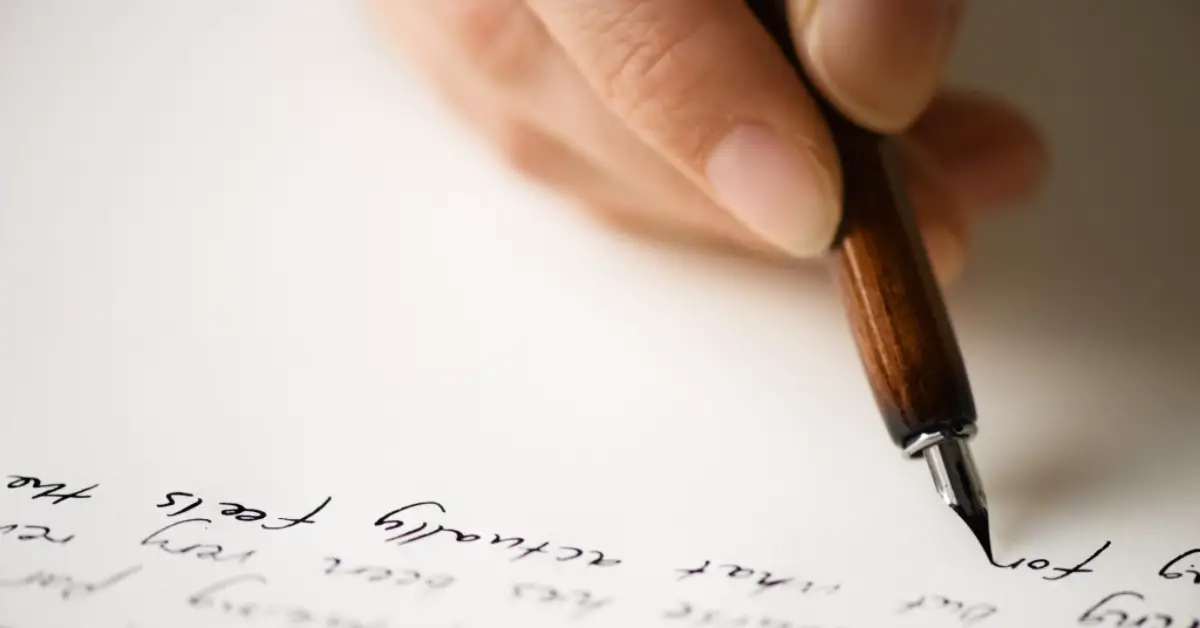What Are Line Breaks In Poetry

Are you ever reading a poem and wondering why the lines stop where they do? Line breaks are not random; they’re essential in shaping a poem’s rhythm and meaning.
This article will dive into the world of line breaks, showing you their importance in poetry and how to spot their influence on the words that dance across the page.
Get ready to see poetry in a whole new light!
Key Takeaways
- Line breaks in poetry end one line and start a new one, which shapes the poem’s rhythm and meaning.
- Unlike prose, where lines continue until the page ends, poets use line breaks for reasons like highlighting words or creating a pause.
- Types of line breaks include enjambed lines that run over to the following line, end-stopped lines with natural pauses at their end, half-lines that put pauses within a single line, and experimental visual poetry where layout plays an important role.
- The way poets break up their lines can make us feel surprised or think deeper about what we are reading.
Definition of Line Breaks in Poetry

A line break in poetry refers to the termination of one line and the beginning of a new line.
It is a critical element that sets poetry apart from prose and plays a crucial role in controlling pacing and adding to the overall impact of a poem.
Termination of one line and beginning of a new line
Poets choose to end a line and start a new one for many reasons. They do this to make their poem’s rhythm feel just right or to highlight particular words.
Ending one line and starting another can surprise the reader or slow them down. It is like taking a breath in the middle of speaking.
This break decides how each line should be read. It shapes how we hear and understand the poem.
The poet uses this tool carefully, knowing where it will lead our thoughts as we move from one poetic line to the next.
Each break creates a space for ideas to grow before diving into what comes after.
Different from line breaks in prose
In prose, like stories or essays, line breaks happen when a writer runs out of room on the page.
They don’t mean anything special and start a new line. But in poetry, every line break is there for a reason.
The poet has chosen where to end one line and begin another.
These breaks can make you pause and think, add rhythm to the poem, or surprise you with an unexpected next word or idea.
This fundamental difference helps give poetry its power. When reading poems, look at how lines are broken up; it can change how you understand the whole piece!
Importance of Line Breaks in Poetry
Line breaks are a crucial element in poetry, setting it apart from prose and allowing poets to control pacing and emphasis.
They add depth and impact to the overall meaning of a poem.
Sets poetry apart from prose
Poetry has its rhythm and beat, formed by line breaks that you won’t find in prose. Words in a story flow like a river from start to finish without stops at the end of each line.
But poetry dances to a different tune. Each break can make a pause, add surprise, or stress certain words more than others.
By controlling where lines end, poets play with how we read and hear their work. They create shapes on the page that pull us into the poem’s world.
Prose sticks to paragraphs; poetry uses stanzas, pauses, and visual gaps that catch our eyes and ears.
This is how poetry turns simple words into influential art.
Allows poets to control pacing and emphasis
Line breaks in poetry allow poets to control the pace at which their work is read.
By deciding where to end a line and begin the next, they can create pauses and emphasis, influencing how readers interpret the poem’s meaning.
These deliberate choices also affect the flow and rhythm of the verses, shaping the overall musicality of the piece.
Understanding this aspect is critical for appreciating a poem’s intended impact, as it directly affects how we experience and connect with the art form.
Moreover, by strategically placing line breaks, poets can highlight specific words or phrases within a poem.
This technique allows them to draw attention to specific ideas or emotions while guiding readers through an emotional or intellectual journey as they progress through each line.
Adds to the overall meaning and impact of a poem
Line breaks in poetry are not just about where a line ends but also how it impacts the meaning of the poem.
They allow each line to hold its significance and contribute to the overall impact of the piece.
The strategic use of line breaks can affect the sound, rhythm, and syntax of a poem, playing a crucial role in shaping its message and emotional resonance.
For example, by breaking a line at a certain point, poets can create tension or emphasize specific words or ideas within the poem, ultimately enhancing its overall effect on the reader.
Understanding how to utilize line breaks in poetry effectively is essential for both appreciating and creating influential poetic works that resonate with readers.
It’s not just about where one chooses to end a line; it’s about how that choice influences every aspect of the poem’s expression and delivery.
Types of Line Breaks
- Enjambed lines, where the sentence or phrase continues onto the following line without punctuation
- End-stopped lines, which have a natural pause or stop at the end of each line
- Half lines/ caesuras, which break up the flow of a line with a sudden pause or interruption
- Experimental lines/ visual poetry, where poets play with the layout and appearance of the poem on the page
Enjambed lines
Enjambed lines in poetry are like a seamless flow, where one line moves smoothly into the next without punctuation.
They create a sense of continuity and rhythm, allowing the words to spill over from one line to another.
This technique gives poets flexibility in controlling the pacing and meaning of their work, adding depth and complexity to the overall impact of a poem.
Considered poetic bullion, enjambment can be likened to an intimate, interrupted conversation between final lines.
It’s like a continuous movement within the poem, elevating it beyond regular sentence structure.
End-stopped lines
End-stopped lines in poetry are when a sentence or idea finishes at the end of a line.
You can identify them by seeing a complete thought that ends on one line, followed by punctuation.
This creates a natural pause before continuing to the following line, adding emphasis and shaping the rhythm of the poem.
Understanding end-stopped lines is crucial for appreciating how poets control pacing and meaning in their work.
It offers insights into how they use punctuation and syntax to craft each line deliberately.
Half lines/ caesuras
When it comes to poetry, the use of half-lines and caesuras adds an intriguing twist.
A half line is a poetic line break that occurs within the flow of a single line, often marked by a caesura – creating a pause or gap.
This pause disrupts the regular rhythm, injecting depth and complexity into the poem’s structure and overall rhythm.
Caesuras can occur anywhere in a line, breaking up the metrical pattern and shifting emphasis to different parts of the poem.
They act as upbeats, contributing to the dynamism and musicality of poetry and and enhancing its impact on readers.
Experimental lines/ visual poetry
In experimental and visual poetry, line breaks can do more than create pauses or rhythm.
They can form unique visual patterns on the page, enhancing the poem’s aesthetic appeal.
Visual poetry often uses unconventional line breaks to convey meaning and emotion through its visual representation, relying on innovative line breaks to make an impact.
Furthermore, experimental lines in poetry may disrupt traditional grammar and syntax for artistic effect, showing how experimenting with line breaks and graphic elements can genuinely elevate the art of poetry.
Tips for Using Line Breaks Effectively
Consider the content and meaning of the poem when deciding on line breaks.
Use line breaks to create tension and surprise, and experiment with different styles to find what works best for your poem.
Consider the content and meaning of the poem.
Line breaks in poetry are crucial elements that can affect the meaning and impact of a poem.
When considering the content and meaning of a poem, poets strategically use line breaks to control the flow and rhythm of the poem.
By breaking lines at specific points, poets complicate or confirm the idea of sentences while working with or against the content of the poem.
These deliberate line breaks also force readers to engage with the poem in a certain way and add a particular beat or rhythm, ultimately dividing, structuring, and giving melodic form to poetry.
Poetry lovers and students should understand that poets put line breaks in for a specific purpose – whether it’s to create tension, surprise, or emphasize certain words or phrases within the poem.
Use line breaks to create tension and surprise.
Line breaks in poetry are potent tools to create tension and surprise within a poem.
They allow poets to control pacing and emphasis, adding to the overall meaning and impact of the work.
Irregular line breaks can be used strategically to catch the reader off guard, creating a sense of unease or excitement.
By breaking lines at unexpected points, poets can disrupt the flow of thought or introduce contrasting ideas in quick succession.
This technique works with and against the content of a poem, complicating or confirming the idea of each sentence while allowing for creative expression without relying on punctuation.
With an understanding of how line breaks function in poetry, you can appreciate their role in shaping not only the rhythm but also the emotional resonance of a poem.
It’s through these deliberate line breaks that poets elevate their craft, using white space on the page as an essential part of their artistic expression.
Experiment with different styles of line breaks
Experimenting with different styles of line breaks can add depth and complexity to poetry.
It allows poets to evoke various emotions and reactions from the reader by creatively controlling the pacing and rhythm of their poems.
By playing around with line breaks, poets can find their unique voice and style in writing poetry, breaking away from traditional rules to create surprising effects.
Different styles of line breaks give poets the freedom to experiment with how words are visually presented on the page, ultimately enhancing the overall meaning and impact of a poem by creating tension and surprise.
Concluding Thoughts on What Are Line Breaks In Poetry
In conclusion, understanding line breaks in poetry is essential for appreciating the distinctiveness of poetic expression.
It sets poetry apart from prose, allowing poets to control pacing, emphasis, and meaning.
By mastering the effective use of line breaks, poets can create powerful and impactful pieces that resonate with readers.
Through thoughtful consideration and experimentation with different styles of line breaks, poets can elevate their craft and convey emotions with depth and nuance.
Ultimately, recognizing the significance of line breaks enriches our experience of poetry and encourages creativity in its interpretation.
FAQs About What Are Line Breaks In Poetry
1. What is a line break in poetry?
A line break in poetry is where a line of the poem ends and the next one starts. It helps make the poem’s rhythm and can add tension or pause.
2. How do poets use line breaks?
Poets use line breaks to control how their poem sounds, to create a special shape on the page, or to surprise readers with an unexpected turn between lines.
3. Can you explain what a stanza break is?
Sure! A stanza break is like a little gap between groups of lines in a poem, which we call stanzas. It gives readers a chance to rest before moving on.
4. What’s different about writing prose versus poetry with line breaks?
When you write prose like stories or essays, you fill up each line until you reach the end of your idea or paragraph. In poetry, writers choose when to end each line even if it’s in the middle of an idea.
5. Why might poets experiment with really short or long lines?
Using very short or long lines changes how fast someone reads the poem and what words stand out as important—it affects the overall feeling of reading it!
6. Can anyone decide where to put line breaks in their poems?
Yes! Even though there are some common ways to use them for rhyme and rhythm, every poet gets to choose where they want their lines broken—there’s no single right way!
Source URLs
- https://writers.com/line-breaks-in-poetry
- https://poemshape.wordpress.com/2011/03/26/recognizing-using-caesuras-enjambment-and-end-stopped-lines/
- http://spinelessbooks.com/theory/linebreaks/
- https://poemanalysis.com/literary-device/line-break/
- https://owlcation.com/humanities/Lineation-A-Guide-to-the-Line-Break-in-Poetry
- https://notesofoak.com/discover-literature/poetic-line-breaks-guide/
- https://www.linkedin.com/pulse/understanding-poetry-place-punctuation-poem-kukogho-iruesiri-samson

